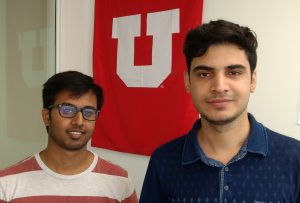Mehdi was awarded Graduate Student Researcher of the Year from the Thermal Fluids and Energy Systems group here at Utah Mechanical Engineering. Congratulations Mehdi!
The award recognizes his work during the 2017-2018 academic year, including mentorship of other group members and publications
- J. Ali, U. K. Cheang, J. D. Martindale, M. Jabbarzadeh, H. C. Fu, and M. J. Kim. “Bacteria-inspired nanorobots with flagellar polymorphic transformations and bundling.” Scientific Reports 7, 14098 (2017).
- M. Jabbarzadeh and H. C. Fu, “Dynamic instability in the hook/flagellum system that triggers bacterial flicks,” Phys. Rev. E, 97, 012402 (2018).
- M. Jabbarzadeh and H. C. Fu, “Viscous constraints on microorganism approach and interaction,” J. Fluid Mechanics, 851, 715-738 (2018).
- M. A. Constantino, M. Jabbarzadeh, H. C. Fu, Z. Shen, J. G. Fox, F. Haesebrouck, S. K. Linden, and R. Bansil. “Bipolar lophotrichous Helicobacter suis combine extended and wrapped flagella bundles to exhibit multiple modes of motility.” Scientific Reports 8, 14415 (2018).
As part of a group of investigators, we have received an award to develop mathematical models of the gastric mucus layer and use them to understand bacterial infection in the stomach as well as gastric organoids, spherical reconstructions of gastric tissue that can be used to study gastric function and disease. Besides our group, the team consists of Aaron Folgelson (PI), James Keener, and Owen Lewis in U Utah Mathematics, Jian Du at the Florida Institute of Technology, Rama Bansil at Boston University, and James Wilking and Diane Bimczok at Montana State University.
[Modeling Gastric Mucus Layer Physiology, NIH 1R01GM131408-01]
Mehdi has published a paper investigating how viscous constraints influence the ability of swimmers using different swimming strategies to closely approach other suspended particles, for example to feed, mate, or find new habitats.
[M. Jabbarzadeh and H. C. Fu, “Viscous constraints on microorganism approach and interaction,” J. Fluid Mechanics, 851, 715-738 (2018).
pdf]
We received a second NSF award to study how the physical constraints posed by viscous hydrodynamics influences the form and swimming strategies of microorganisms. This award is in collaboration with Rob Stoll, also in our department at the University of Utah.
[CBET-1805847, Viscous Constraints on Zooplankton Approach and Interaction]
In collaboration with MinJun Kim at Southern Methodist University, we have received a new NSF award to study how contact interactions between microorganisms and the microstructure of complex media affect swimming. We will combine experiments using artificial bacteria and synthetic mucus with theory and modeling.
[CMMI-1760642, Collaborative Research: Controlled Investigation of Micro- and Nanoscale Contact Interactions Between Microbes and Biomaterials Using Artificial Bacteria]
Mehdi has published an article describing how the dynamical buckling of bacterial hook and flagella combine to trigger flick motility in monotrichous bacteria. His model is the first to quantitatively predicts the onset of flicks seen in experiments. [M. Jabbarzadeh and H. C. Fu, “Dynamic instability in the hook/flagellum system that triggers bacterial flicks,” Phys. Rev. E, 97, 012402 (2018).
pdf]
JD and Mehdi, in collaboration with Jamel Ali and MinJun Kim’s group at Southern Methodist University, have published a new paper describing artificial bacteria-inspired nanorobots. The nanorobots consist of a magnetic nanobead to which is attached one or two reconstituted bacterial flagella. The swimming speeds of the robots can be altered by triggering polymorphic transformations in the flagella, and nanorobots with multiple flagella display bundling-like behavior.
[J. Ali, U. K. Cheang, J. D. Martindale, M. Jabbarzadeh, H. C. Fu, and M. J. Kim. “Bacteria-inspired nanorobots with flagellar polymorphic transformations and bundling.” Scientific Reports 7, 14098 (2017).
pdf ]
New PhD students Suraj Kamarapu and Hossein Moghimifam joined the lab in Fall 2017! We are happy to have them with us!

JD has published a paper on using the polymorphic transformations of bacterial flagella to create a flagellar forest which can change pumping directions autonomously in response to environmental cues. This work was inspired by our collaboration with MinJun Kim’s group at Southern Methodist University.
[J. D. Martindale and H. C. Fu, , “Autonomously responsive pumping by a bacterial flagellar forest: a mean-field approach.” Phys. Rev. E 96, 033107 (2017).
pdf]
Xinhui Shen, Marcos, and Fu have published a paper on using boundary tractions to undersetand the effects of boundaries on microswimmers. Xinhui is a PhD student at Nanyang Technological University advised by Marcos.
[X. Shen, Marcos, and H. C. Fu. “Traction reveals mechanisms of wall effects for microswimmers near boundaries.” Phys. Rev. E 95033105 (2017).
pdf]


